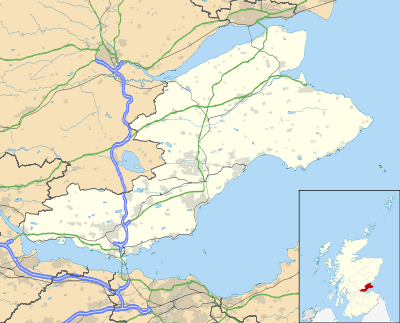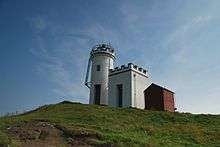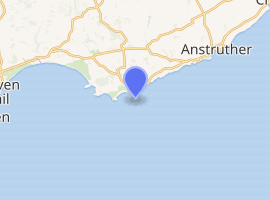Elie and Earlsferry
Elie and Earlsferry is a coastal town and former royal burgh in Fife, and parish, Scotland, situated within the East Neuk beside Chapel Ness on the north coast of the Firth of Forth, eight miles east of Leven. The burgh comprised the linked villages of Elie (/ˈiːli/ EE-lee) and Earlsferry, which were formally merged in 1930 by the Local Government Act of 1929. To the north is the village of Kilconquhar and Kilconquhar Loch.
| Elie and Earlsferry | |
|---|---|
 Elie and Earlsferry Location within Fife | |
| Population | 861 (2011)[1] |
| OS grid reference | NO4900 |
| Council area | |
| Lieutenancy area | |
| Country | Scotland |
| Sovereign state | United Kingdom |
| Post town | Leven |
| Postcode district | KY9 |
| Dialling code | 01333 |
| Police | Scotland |
| Fire | Scottish |
| Ambulance | Scottish |
| UK Parliament | |
| Scottish Parliament | |
 Elie Ness Lighthouse | |
 Scotland | |

| |
| Location | Elie Ness Fife Scotland United Kingdom |
|---|---|
| Coordinates | 56.183987°N 2.812717°W |
| Year first constructed | 1908 |
| Construction | masonry tower |
| Tower shape | cylindrical tower with balcony and beacon (lantern removed) |
| Markings / pattern | white tower, black trim |
| Tower height | 11 metres (36 ft) |
| Focal height | 15 metres (49 ft) |
| Light source | mains power |
| Range | 18 nautical miles (33 km; 21 mi) [2] |
| Characteristic | Fl W 6s. |
| Admiralty number | A3060 |
| NGA number | 2552 |
| ARLHS number | SCO-074 |
| Managing agent | Forth Ports[3] |
The civil parish has a population of 861 (in 2011).[1]
Ancient times
Earlsferry, the older of the two villages, was first settled in time immemorial. It is said that MacDuff, the Earl of Fife, crossed the Forth here in 1054 while fleeing from King Macbeth. In particular the legend tells of his escape being aided by local fishermen, an act which may have led directly to the village being promoted to royal burgh status due to MacDuff's later influence over Malcolm III.[4]
By the middle of the 12th century, the Earls of Fife had instituted a ferry for the use of pilgrims en route to the shrine of Saint Andrew the Apostle at St Andrews. The ferry crossed the Firth of Forth to North Berwick, a distance of 7 miles, and it is this ferry that led to the naming of the place. There are the remains of a small chapel on Chapel Ness, built for the use of these pilgrims.
Jun2003.jpg)
The exact date of Earlsferry being made a Royal Burgh is unclear as its original charter was destroyed in a fire. Earlsferry became a trading port for merchants and remained so until the 18th century, and was also an important calling point on the pilgrims' route from the south to St Andrews. A new charter was granted in 1589 by James VI.[4] Little is known of the foundation of Elie, but it had become sufficiently important to merit the building of Elie Parish Church in 1639. Its harbour was more sheltered than that of Earlsferry and it began to poach trade away from Earlsferry.
The etymology of the name Elie is unclear. The name may derive from the Scottish Gaelic ealadh which means 'tomb', or èaladh which means 'a passage for boats between two rocks', or ail plus the suffix in which means 'rock-place'.[5][6]
Buildings
Elie has an unusual parish church, dating from 1639. It has a tall octagonal tower, topped with a belvedere detail, centrally located on the church. It is approached on axis from the High Street, increasing the drama of its architecture, and surrounded by a churchyard burial ground.
On the outer corner of the churchyard wall, where the main road makes a right angle, stands the village war memorial. This is of particularly poignant composition, as each name listed also states their trade before the war and their battalion number and regiment. This therefore highlights a number of "ploughmen" and a high ratio of "chauffeurs". It may be speculated that the latter were in service on the several large country estates encircling the village.
Elie House is an interesting Scots vernacular extended tower house, standing close to the waterline. Superficially it dates largely from the early 17th century but contains older elements possibly from the 15th century. The High Street nearby contains several good 17th century houses with curious doorpieces.
'Muircambus House' is a Scottish baronial mansion on the north west side of Elie.
In the 1770s the Lady's Tower was built in Ruby Bay, on the east side of Elie Ness, for Janet, Lady Anstruther. It incorporated a vaulted chamber at sea level as a changing room. It is said that Lady Anstruther would bathe in the nearby waters, a servant ringing a bell all the while to ensure locals stayed away.[7][8] The daughter of Provost Charles Fall of Dunbar, she was mentioned by Thomas Carlyle as Jenny Faa, "a coquette and a beauty". She caused the hamlet of Balclevie, to the north of Elie House, to be razed ostensibly "to improve the view" but widely thought to be because the tinker inhabitants reminded her of her family's own origins. This may have been Walter Scott's inspiration for a similar incident in Guy Mannering.[9] [10]
Post-Reformation
After the Scottish Reformation, pilgrimages and other traffic waned in Earlsferry;[11] so much so that when Earlsferry harbour was filled with sand by a severe storm in 1766, the remaining trade moved to Elie.
Sport
Golf and Tennis
Elie and Earlsferry are about ten miles due south of St Andrews. Golf is believed to have been played on Earlsferry Links as early as the 15th century, and the layout evolved over time into the current magnificent 18-hole course which has remained largely unchanged since 1895.
There has been a formal golf club here in Elie and Earlsferry since 1832. The current club, the Golf House Club, was founded in 1875 with the building of the clubhouse. An unusual feature is the periscope from the submarine HMS Excalibur. It was installed in the starter's hut after the submarine was scrapped in 1968; players and visitors may use it to view the golf course.[12]
Golfers, clubmakers and course designers James Braid, Archie Simpson, and Isaac Mackie were born in Earlsferry.[13][14]
Neighbouring the Golf House Club is the Elie Sports' Club which encompasses a multi-sports facility available 7 days of the week, 364 days of the year. Its facilities include a 9-hole golf course (2080 yards long), a putting course, a driving range with covered bays and outdoor hitting areas and a short game practice area with 2 bunkers and a 50-yard pitching fairway. There are also 5 full size tennis courts and 4 short tennis courts along with a Bowling Green and Club [15]
Cricket
Elie has a cricket club who are based in The Ship Inn pub on the beachfront. The team arrange all their home fixtures in line with the tides and play them on the beach when the tide is out.[16]
Modern times
Elie's harbour was expanded in 1850. The nearby railway, part of the Fife Coast Railway, was built in 1857, and extended through Elie to Anstruther in 1863.[4] The villages opened up to the affluent tourist trade of Victorian times in the 1870s, which saw regular steamers from North Berwick and Leith.[17]
The explosion of modern communications saw the nature of the local economy change. Coal mining dwindled after the railway came to the area. Cotton weavers abandoned their trade after the switch to linen made from imported flax. Fishing gradually declined. The growing tourist trade caused a local building boom, which would have provided work for stonemasons. There were also golf club makers in the village for many years. Various support trades existed in the villages over the years and persisted until the advent of modern road transport around 1970.[4]
Elie and Earlsferry were formally merged in 1930. The modern villages now largely share shops and other facilities, but they do retain a flavour of their historical identities.
In recent decades, the town has become a very popular destination for wealthy residents of Glasgow and Edinburgh. In the summer months the town's population is several times higher than it is during the winter. Attractions include the beach, golf, restaurants, surfing and sailing.
The railway line fell under the Beeching Axe in the 1960s and the station and tracks were subsequently closed and dismantled, leaving Elie with only road and sea transport links.
Notable events
The film The Winter Guest, starring Emma Thompson and Phyllida Law, directed by Alan Rickman, was filmed here.[18]
Notable residents
- Catherine Calderwood FRCOG, FRCPE, Northern Irish consultant obstetrician and gynaecologist, and Chief Medical Officer for Scotland from 2015 to 2020.
- David Cunningham Greig FRSE geologist, retired to Elie and died there.
- William Dudingston, Rear Admiral, Royal Navy. Dudingston was commander of the schooner HMS Gaspee, which after interfering with smugglers in the Colony of Rhode Island was led aground and burned by American patriots in June 1772. This is referred to as America's "First Blow for Freedom" and a spark to the American Revolution.[19]
- James Horsburgh, hydrographer.[20]
- William Quarrier Kennedy FRS, FRSE, FGS, Scottish Geologist, resided in Elie between 1967 and 1977.
- Jean Redpath MBE, eminent interpreter of Scots song.[21]
- Walter W. Robertson, architect.
- Robert Traill, author and prisoner on the Bass Rock.
Trivia
The famous "Floral clock" in Edinburgh's Princes Street Gardens was originally constructed (1903) using the clock mechanism salvaged from Elie Parish Church.[22]
References
- Census of Scotland 2011, Table KS101SC – Usually Resident Population, publ. by National Records of Scotland. Web site http://www.scotlandscensus.gov.uk/ retrieved March 2016. See "Standard Outputs", Table KS101SC, Area type: Civil Parish 1930
- Elie Ness Lighthouse Lighthouse Explorer. Retrieved 13 May 2016
- Elie Ness The Lighthouse Directory. University of North Carolina at Chapel Hill. Retrieved 13 May 2016
- "A Potted History of Earlsferry". Elie and Earlsferry Online. Archived from the original on 25 October 2007.
- Simon Taylor, the Place-Names of Fife, five volumes (Donington: Tyas, 2006-12), iii 274.
- "Fife Place-name Data :: Elie". fife-placenames.glasgow.ac.uk.
- Mackintyre, Lorn (2008). Portrait of the East Neuk. Alvie. p. 124. ISBN 9780951180051.
- "Fife business - Lady's Tower". Welcometofife.com. Retrieved 5 April 2020.
- Lamont-Brown, Raymond (2002). Fife in History and Legend. London: John Donal Publishers. pp. 119–120.
- Pride, Glen L (1999). The Kingdom of Fife. Rutland Press. p. 166.
- "A Walk Around Earlsferry". Elie and Earlsferry Online. Archived from the original on 10 October 2007.
- Ronnie Leask (12 October 2008). "NO4800 : Periscope in starters hut Elie Golf Course". www.geograph.org. Retrieved 19 September 2011.
- "The Golf House Club History". The Golf House Club, Elie.
- "Archie Simpson". Antiquegolfscotland.com. Retrieved 5 July 2014.
- "Elie Sports Club".
- Witherow, John, ed. (14 August 2017). "Hit for shore". The Times (72301). p. 10. ISSN 0140-0460.
- The Scottish tourist and itinerary; or, A guide to the scenery and antiquities of Scotland and the western islands: with a description of the principal steam-boat tours. Stirling & Kenney. 1831. p. 361.
- "The Winter Guest - Scotland the Movie Location Guide". Scotlandthemovie.com. Retrieved 5 April 2020.
- Volo, James M. "William Dudingston". Gaspee.org. Retrieved 5 April 2020.
- Groome, Francis Hindes (1882). Ordnance gazetteer of Scotland : a survey of Scottish topography, statistical, biographical, and historical. Edinburgh : T.C. Jack. pp. 569–570. Retrieved 8 March 2019.
- "LOCAL WORTHIES - Jean Redpath MBE (1937-2014)". Elie & Earlsferry History Society. 6 November 2016.
- Monuments and Statues of Edinburgh, Michael T.R.B. Turnbull (Chambers) p.5
- Wilkinson, M. and Tittley, I. 1979. The marine algae of Elie, Scotland: a Re-assessment. Botanica Marina 22: 249 - 256.
External links
| Wikimedia Commons has media related to Elie and Earlsferry. |
| Wikisource has the text of the 1911 Encyclopædia Britannica article Elie. |
- Elie Parish Church
- Elie Parish Church article on ElieOnline
- Elie and Earlsferry Online community
- Elie and Earlsferry History Society
- The Golf House Club, Elie
- Amenities in Elie, Fife
- Elie and Earlsferry Sailing Club
- Electric Scotland article about Elie
- Electric Scotland article about Earlsferry
- Northern Lighthouse Board